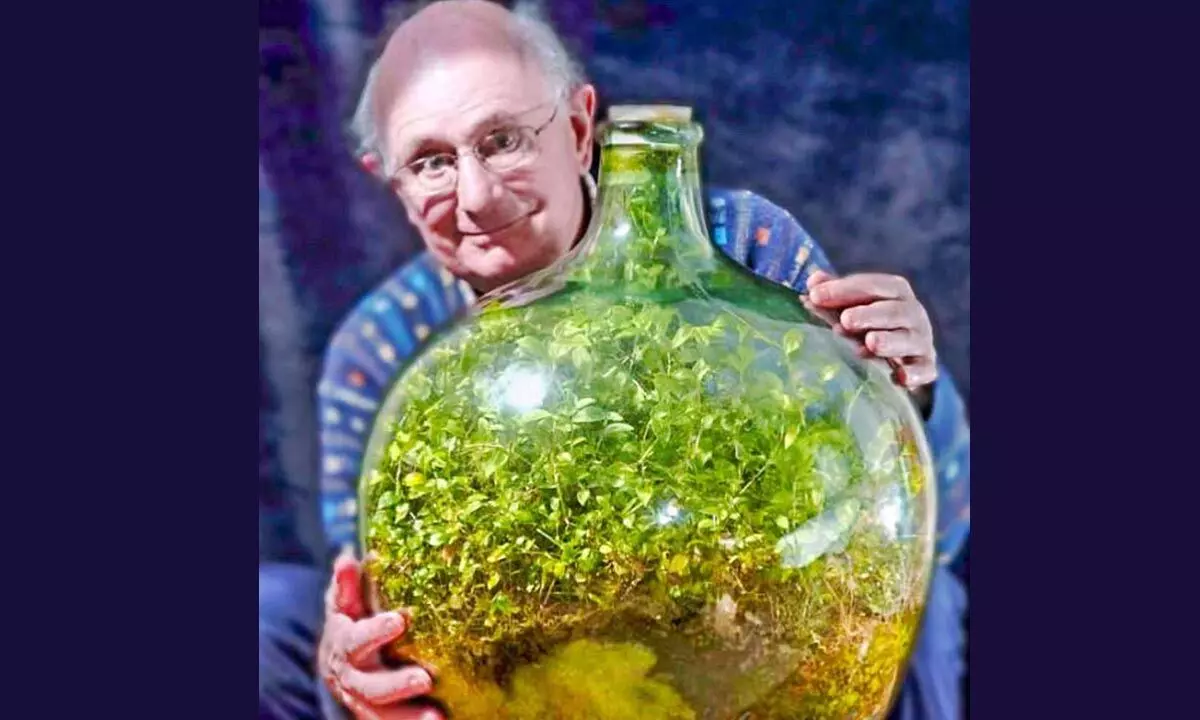Sealed Terrarium, Dubbed as world's Oldest Terrarium

The above Terrarium, has not been watered, since 1972.
Over the years, David bottle garden was very much sealed, and it remained shut but still it remained healthy and robust as it can be.
In the year, 1960, David Latimer decided to grow a sealed glass bottle terrarium, but he never imagined, it would grow into an incredible research study and it would be dubbed as "the world's oldest terrarium.
Over the years, David bottle garden was very much sealed, and it remained shut but still it remained healthy and robust as it can be. It has got flourishing plant live even though it has not been watered since 1972.
David established the terrarium by placing a quarter pint of compost and water inside the ten-gallon bottle (you can get it, by custom made). Later, he added spiderworts seeds, with the help of a wire. After that, he sealed the bottle and put the bottle in a corner filled with sunlight. Then, he allowed the nature to do its job through photosynthesis.
Photosynthesis releases oxygen as well as moisture into the air via plants. The water would then build up and drip onto the plants. The leaves would also fall and rot, thus releasing the carbon di oxide, which the plants require for their food.
It is creating a self-sustaining ecosystem. It is stunning illustration as to how nature can preserve itself.
Latimer opened the terrarium in the year, 1972, to supply the plants with water, however, it has been sealed with no air or freshwater ever since.
It is about six feet from a window, so it is exposed to sunlight. As a result, it is a little more oriente towards the sun and it is rotated around now and then to develop uniformly. It is also standard for low maintenance. David has stated that, he never trimmed it, it just appears to have grown to the boundaries in the bottle.
The garden has been set in the same room for the past 27 years at home of the Latimer family. It is situated within Cranleigh, Surrey.
The designer stated that, David's sealed garden was the perfect cycle of nature and it is excellent illustration of the ability of plants to recycle. And he added, that it is similar to the NASA is looking into bringing plants and seeds into space.
Plants server as excellent cleaners, eliminating pollution from the air, to ensure that a space station can be self-sustaining.
This one, is an perfect example as to how revolutionary plants are and how they can survive if given a chance.
History of terrains
If you are new to terrariums, let's start with some background. The name terrarium comes from the Latin words terra (earth) and arium(place). So, it is similar to aquariums, but only with earth and plants.
There are two main categories of Terrariums
Closed: The most classic (and interesting) kind and the one David chose to create. The sealing off of the terrarium and making it an enclosed system is what makes it an ecosystem. It captures humidity in terrarium and allows for the growth of fascinating tropical plants.
Open: This type might lose few of a traditional terrarium's essential characteristics and features. They are ideal for plants that do not require lot of water.
The first terrarium was created accidently, by Nathan Bagshaw Ward.
Ward first became aware of the benefits of hermetically-sealed glass bottles in the year, 1829. He had put a chrysalis from a moth called a sphinx in moist soil on the bottom of the bottle and covered the bottle with a lid. Then, he noticed that a grass and fern and seedling has sprouted from dirt the following week.
Incredibly, the evaporated water condensed on the bottles, walls in the daytime, then returned to the soil at night and maintained constant humidity.
He than adapted this idea for transporting plants across long voyages. The sealed Wardian Case kept the plants moist and alive so they could travel to foreign nations.
Nowadays, terrariums are used more for decoration and enjoyment rather than travel. Although, it is still a great way to transport plants, if you are moving long distances.
Growing Sealed Bottled Terrarium
Sealed terrarium functions by creating a self-sustaining ecosystem. Through photosynthesis, plants recycle nutrients.
Plants store a small amount of light with ATP (Adenosine triphosphate) to offer energy. The plant's roots utilize the rest to remove electrons in water.
The electrons are then free to release oxygen through the conversion of carbon dioxide into carbohydrates by chemical reactions.
To compost organic matter like dead leaves in the ecosystem, it uses the process of cellular respiration. This is performed by bacteria that absorb excess oxygen release carbon di oxide and help the plant grow.
The plants also use the same process of cellular respiration to break down substances it has stores up in the absence of light (during nightime)
Water is cycled throughout, trapped in the plant's roots, escaping into the air and condensed in the potting mix
The cycle begins anew and continues to repeat itself.
David plans to pass on the world's oldest terrarium to his children once they are older. Even if they do not have an interest in the meanwhile, if they do not want it, the terrarium will go to the Royal Horticultural Society in London, England.
This simple project at home, helps easily connect to the nature.
















